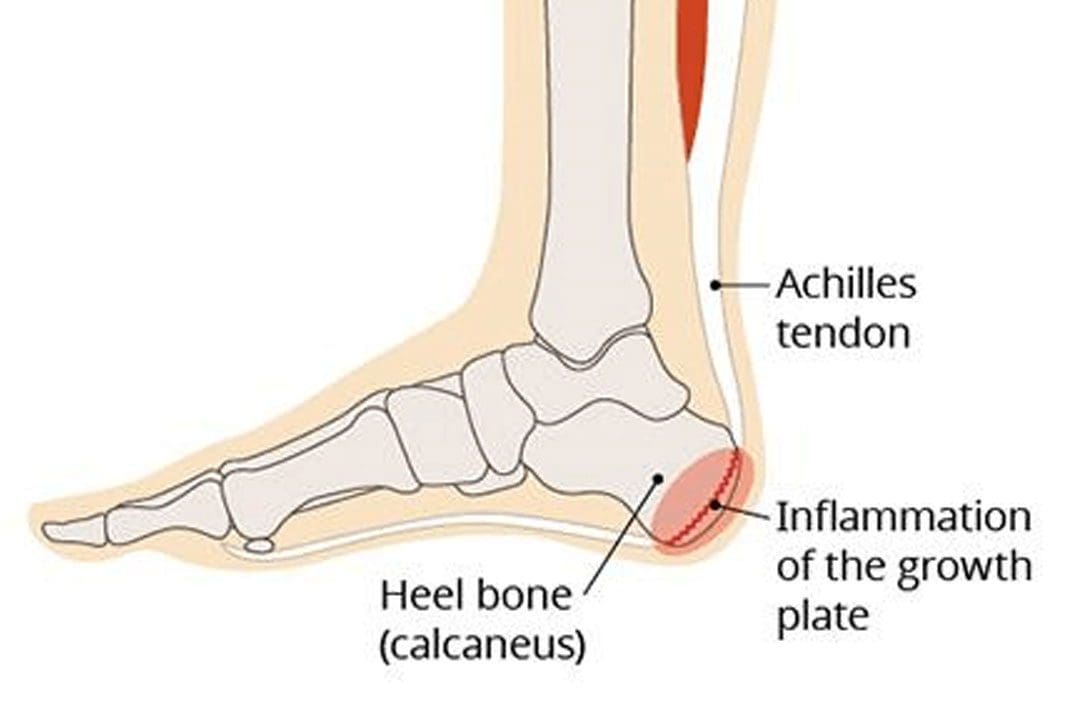Heel pain in children isn’t normal — and it shouldn’t be ignored. If your child is between the ages of 8 and 14 and has started limping, walking on their toes, or avoiding physical activity, Sever’s disease could be the reason.
Sever’s disease (also called calcaneal apophysitis) is one of the most common causes of heel pain in physically active children and adolescents. This condition occurs when the growth plate in the heel bone (calcaneus) becomes inflamed, usually during periods of rapid growth spurts that are typical in pre-teens and teenagers.
The heel’s growth plate is essentially a soft area of developing cartilage where new bone growth occurs. During times of rapid growth, the heel bone grows faster than the surrounding muscles and tendons, particularly the Achilles tendon. This growth imbalance, combined with repetitive stress from sports, running, and everyday activities, puts extra tension on the growth plate area — leading to inflammation, pain, stiffness, and often a visible change in how the child moves.
Unlike adult heel conditions, Sever’s disease is specifically related to the developmental changes occurring in growing children, making it a temporary but potentially disruptive condition that requires appropriate management.

Parents should watch for these key indicators that may suggest their child is experiencing Sever’s disease:
The pain associated with Sever’s disease is typically described as aching or sharp, and may affect one or both heels. Some children experience symptoms that come and go, while others have more persistent discomfort.
Several factors can increase a child’s likelihood of developing Sever’s disease:
Physical factors include having tight calf muscles or Achilles tendons, flat feet or high arches, leg length differences, and being overweight, which places additional stress on the heel area.
Activity-related factors encompass participation in high-impact sports like basketball, soccer, gymnastics, or athletics, training on hard surfaces, sudden increases in activity levels, and wearing inappropriate or worn-out footwear that lacks proper support or cushioning.
Developmental factors include the natural growth spurts that occur between ages 8-14, with peak incidence often occurring around ages 10-12 when growth is most rapid.
While Sever’s disease typically resolves naturally once the growth plate matures and closes (usually by age 15-16), the condition can persist for several months and significantly impact a child’s participation in school sports, recreational activities, and daily life. Left unaddressed, prolonged heel pain may also affect their confidence, physical development, and overall enjoyment of movement and sport.
Early intervention is crucial not only for pain relief but also for preventing compensatory movement patterns that could lead to other issues in the legs, hips, or back. Children who continue to participate in activities while experiencing pain may develop altered walking or running patterns that persist even after the heel pain resolves.
Professional assessment can help determine the exact cause of heel pain, as several conditions can mimic Sever’s disease. A thorough evaluation ensures appropriate management strategies are implemented and helps rule out other potential causes of discomfort.
At AC Podiatry, we offer comprehensive assessments for children experiencing heel pain, including a detailed review of movement patterns, footwear analysis, and lower limb development evaluation. Our assessment process involves understanding your child’s activity levels, examining their foot structure and biomechanics, and developing an individualised management plan.
Understanding the underlying cause of your child’s heel pain is the first step in helping them return to their favourite activities safely and comfortably. Treatment approaches may include activity modification, stretching programs, appropriate footwear recommendations, and other supportive measures tailored to your child’s specific needs.
If your child is showing signs of heel pain or you’re concerned about their movement patterns, early intervention can make a significant difference to their comfort and activity levels. Book an assessment with our experienced team today to discuss the best evidence-based options for managing their symptoms and keeping them active and moving confidently.
Remember: This information is general in nature and should not replace professional medical advice. Always consult with a qualified healthcare provider for assessment and treatment recommendations specific to your child’s situation.